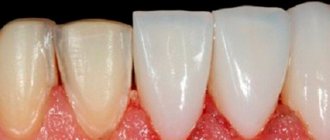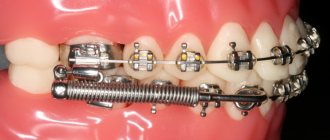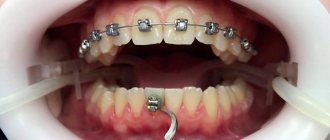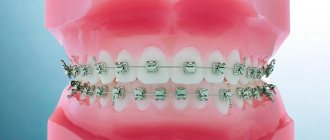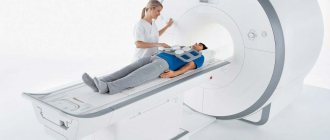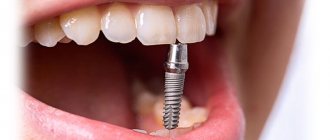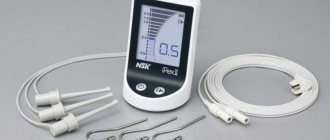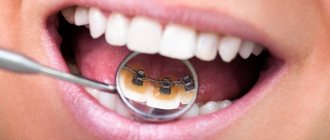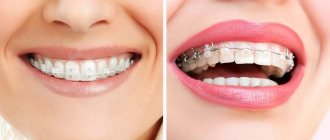Everything you would like to know about correcting your bite and straightening your teeth with braces.
Let's be honest: in modern realities, a beautiful smile is the norm, and it is necessary to get rid of dental imperfections. But, having set such a goal, it is desirable to have reliable information about existing methods and upcoming tests. We tried to collect in one article all the most important things about braces in order to save you from having to look for answers on your own on the Internet, where the truth is mixed with myths and advertising fluff.
Important!
In the article, prices are indicated for St. Petersburg and the Leningrad region.
How are braces different from aligners?
This question worries many: is it possible to pay more, but get by wearing transparent removable aligners? The truth is that nice aligners can only cope with minor problems (for example, with one tooth that has grown incorrectly), but only fixed structures - those same “ugly braces” - can create an orthodontic load to shift the dentition.
As for cap-aligners, to achieve the effect, it is recommended to wear them at least 22 hours a day, removing them only during meals. As practice shows, a person often violates such rules by being distracted, forgetting, or simply allowing himself some indulgence. Strictly speaking, aligners are not intended to correct bites, and if they are positioned as such on the clinic’s website, it is better to turn to other specialists.
And the financial point: you will have to pay not more for the aligners, but much more, because during the treatment period they need to be changed at least 15 times (and sometimes much more), so the average minimum cost of correction with the help of aligners should be considered an amount of about 250- 300 thousand rubles.
What will help you cope with pain?
If you follow all the doctor's recommendations and properly care for your teeth and braces, pain may not occur at all, only some discomfort.
If the pain does not go away, then it is worth checking how the braces are installed; perhaps some mistakes were made that only a doctor will correct.
What other recommendations might there be for patients experiencing pain in braces?
- Dietary restrictions - switching to liquid and pureed foods. - How do you like this option?
- Treatment of braces with dental wax.
- Take painkillers only as prescribed by a doctor!
Diet restrictions
If you have braces, be prepared to change your diet and avoid foods that are hard, fibrous, or too hot or cold. Because this can break your braces, damage your teeth, or increase pain.
After installing the system, you should wait at least one hour before you can eat liquid or soft food. Soups, pureed porridge and even baby food are the basis of your diet during bite correction. And, by the way, you will have to brush your teeth very, very carefully, since food will constantly get stuck there, forming plaque:
Special wax
In pharmacies you can buy orthodontic wax, which is applied to braces and helps reduce pain from friction and pressure of the device on the mucous membranes and teeth.
Taking painkillers
Any medications, even the seemingly safest ones, should be used only after consultation with a specialist and after carefully reading the instructions, contraindications and side effects of these medications. By mindlessly taking any medications, you can only seriously harm yourself, always remember this!
For irritation of the mucous membrane, rinsing with chamomile decoction helps a lot. Of course, with one “but” - if you are not allergic to it.
CONCLUSION
: In case of any incomprehensible sensations, we recommend that you contact your doctor so as not to miss serious points during treatment.
We still have one important question, which we promised to answer at the very beginning of the article, here it is:
Installing and wearing braces: does it hurt?
When installing braces, the vast majority of patients do not experience any noticeable pain, but discomfort certainly appears, and you will have to get used to the braces - for some faster, for others longer, on average - 1-2 days. The exception is, perhaps, people with a very low pain threshold or with increased impressionability - it is from them that the myths about the pain of installing and wearing braces come.
In fact, sometimes there is irritation of the mucous membranes of the lips and cheeks. To solve this problem, a special wax is used, which the doctor will definitely suggest after installation.
How to reduce pain during the adaptation period?
To make the adaptation process easier, dentists usually give recommendations that must be followed during the first weeks after installing braces.
- Review your diet towards gentle, soft foods.
- It is preferable to eat food with a creamy, liquid consistency or crushed. An excellent solution during this period would be purees, smoothies, yoghurts, and semi-liquid cereals.
- Apply wax to braces.
Even the highest quality structural elements will initially rub the mucous membrane, causing discomfort to the patient. The use of special wax helps prevent or at least reduce damage to the mucous membrane by elements of the orthodontic structure. This product is applied to the clasps and other protruding parts of braces, due to which they become smoother and no longer injure soft tissues. Orthodontic wax is harmless to the patient, and it can be used not only during the adaptation period, but also later - during the entire period of treatment if necessary. It is important to stick wax to pre-cleaned braces.
- Rinse your mouth.
When teeth are moved under the influence of the orthodontic apparatus, the gums often begin to ache and ache. Special rinses help relieve pain and discomfort. A dentist will help you choose the optimal remedy.
- Take painkillers.
If the pain greatly bothers the child, you can give him Ibuprofen, Paracetamol or another painkiller that can be used according to age. Important! If the pain does not go away for a long time or gets worse, you should definitely show the teenager to a doctor.
I’ll take off my braces, a couple of years will pass, and my teeth will return to their place... is this true?
But this is true - but from the practice of past years! Now, after removing braces, the dentition is secured using a special non-removable retainer apparatus; previously this was not always done - hence the accumulated complaints. Today, orthodontists are required to install such a device.
A retainer is a thin wire that is installed on the inside of the front teeth and prevents them from moving apart. And this is for the rest of your life, but you shouldn’t worry: the delay is imperceptible, those around you don’t see it, and if it breaks, it’s easy to fix—just don’t delay your visit to the doctor.
Another problem is more pressing: sometimes, after straightening the dentition, previously hidden aesthetic defects (for example, different lengths of teeth) become noticeable. In this case, you will really have to resort to restoration or buy expensive veneers.
Important!
The orthodontist must notice such defects and warn the patient before starting treatment.
How often should inspections be carried out?
Every 1-2 months, it all depends on the defect and the individual structure of the patient’s teeth. During the visit, the orthodontist checks the success of the treatment and sets a vector for the arch, which determines the movement of teeth in the right direction.
Missing follow-up visits may negate the effect of previous treatment. You are also required to visit a hygienist every six months.
Braces, whether external or internal, need to be worn for an average of 1.5 years. But determining more precise timing depends on the initial situation and age of the patient. Sometimes it takes 2 years to eliminate a defect.
Do braces damage enamel and lead to caries?
No, the tight fit of the braces completely eliminates the penetration of food debris and microbes into the tooth; Dental enamel glue used in practice is harmless, moreover, it contains the useful element fluorine. The brace-lock even protects the tooth in a certain way.
But improper care of braces is really fraught with trouble: oral hygiene after installation of an orthopedic structure requires more attention and responsibility due to the increased accumulation of plaque. And where there is plaque, there is caries!
Adaptation.
The length of the adaptation period takes 3-14 days - it all depends on the chosen design, following the dentist’s advice and the individual characteristics of the child. This time is the most difficult, as the teeth get used to the load, acquire some mobility and begin to change their position, trying to take the correct place in the bite. The patient feels severe discomfort and pain. You can reduce discomfort by adjusting the menu towards soft foods and taking prescribed sedatives.
Is it necessary to use additional products to clean braces?
On forums (and sometimes in the recommendations of “experts”!) there are numerous additional products that supposedly make oral hygiene easier in the presence of braces (rinses, ultrasonic brushes, etc.)
In fact, with a responsible approach, it is quite possible to get by with three basic tools (toothbrush, dental floss, brush). In this case, you should not rely on someone else’s opinion. The quality of care will be assessed by a doctor who conducts regular examinations, and he will also recommend additional remedies, if necessary.
Can adults get braces to correct their bite?
Anyone can correct a malocclusion, regardless of age. But in an adult, this process takes longer than in children, because skeletal growth has already stopped and hard bones are more difficult to form.
In addition, some oral health conditions may delay the installation of braces. For example, caries, periodontal disease, endocrine diseases.
Sometimes the effect of treatment is influenced by the presence of crowns and bridges. The treatment period starts from 1.5 years.
Is there a need to give up your usual food?
As a rule, when installing a brace system, the doctor will actually announce “forbidden” foods, and this list looks quite depressing (cookies, chips, seeds/nuts, crackers, chewing gum, pizza, chocolate bars, etc. - everything that can stick to the structure , creating conditions for the proliferation of microbes, or damaging it). But in this case, the doctor’s recommendations should be approached in a differentiated manner: there is a clear reinsurance here, the only thing that is actually required from the patient is caution.
Is it true that sapphire braces are the best?
Sapphire braces are much more expensive than iron braces, but their advantages do not lie in the effectiveness of treatment. Moreover, in reliability they are inferior to metal ones. But on the teeth, such brace systems look much more aesthetically pleasing, since transparent brace locks are almost invisible.
Let us clarify: the precious natural stone sapphire has nothing to do with the production of such briquettes; we are talking about artificially grown crystals.
By the way, there are also cheaper transparent braces - ceramic (much more expensive than metal ones, but not as expensive as sapphires) and plastic designs. Only the former are too fragile and unstable in relation to food dyes (can lead to yellowing of teeth), and the latter are intended only for short-term use.
The impact of malocclusion on health
Malocclusion has a negative impact on human health. We don’t think it’s worth talking about the aesthetic component. Of course, there are no life-threatening indicators, but it is still necessary to get rid of the anomaly, otherwise it will lead to disastrous consequences. First of all, the impact falls on the gastrointestinal tract. This happens due to the fact that a person’s chewing function is impaired. Correcting your bite with braces will help you avoid digestive problems. There are just some contraindications for installation:
- infectious diseases of the oral cavity;
- different sizes of teeth;
- allergies (occurs extremely rarely to metal, but in this case it is possible to install, for example, ceramic structures).
How much do simple metal braces cost?
The remarkable cheapness of hardware is just a myth supported by some clinics. Indeed, by indicating the cost of one element of the braces system, they create the illusion of affordable treatment, but the patient should understand that the treatment process involves paying for braces, dental materials, multiple visits to the doctor and various procedures, including removal of the system at the end of treatment - and all this will cost at a very decent amount.
On average, the price of a course of treatment in an ordinary case (healthy teeth, simple defect) is 150-170 thousand rubles. (and this does not take into account preliminary professional teeth cleaning and diagnostics). If you have tooth decay and/or gum problems, you should add the cost of treatment or surgery to this amount. After removing the braces, you will have to pay for the installation of retainers, and, if necessary, restoration or installation of veneers.
Important!
There is no point in finding out the cost of braces over the phone, since each case is individual; choose the clinic where they will tell you the amount of all necessary procedures and operations - so to speak, the amount of “turnkey” treatment.
Cons and contraindications
We have already partially written about the disadvantages of brace systems above. All of them are not so significant as to make you doubt whether to put braces on your jaw. The main ones include possible damage to the enamel, complicated oral care, time and cost of treatment.
In what cases can orthodontic treatment not be carried out? There are not many absolute contraindications: epilepsy, tuberculosis, HIV, developmental features. The rest are relative: the presence of untreated teeth and inflammatory processes in the oral cavity, severe tooth wear, some diseases of the cardiovascular system, exceptional cases. The dentist will be able to accurately answer whether the bite needs to be corrected in your situation after examination and diagnosis.
What are the advantages of ligature-free braces? And do they exist?
Ligatures are wires or elastic rings with the help of which bracket locks are attached to the arch. In ligature-free bracket systems, the arch is inserted into a special clip, and ligatures are not needed.
Self-ligating braces (also known as self-ligating braces) have been aggressively promoted for some time, causing their prices to rise. However, time and practice have shown that the advantages attributed to such systems are absent (including the myth about the special strength achieved due to minimal friction of the archwire with the bracket locks).
Ligature and self-ligating systems
Ligatures are additional elements of the bracket system that hold the arch in the groove of the lock. At the initial stage of treatment, pieces of thin wire are used as ligatures. Then they are replaced with elastic bands. The main purpose of the ligatures is to ensure the movement of the clasps following the changing shape of the arch. The wire fixes the braces very tightly, which often leads to uneven load on the teeth. In this regard, aching pain may appear that an adult, let alone a child, can hardly endure. Rubber bands are stained with pigments from food and drinks, which requires their regular replacement.
In self-ligating systems, the clasps have a special clip that secures the arch. The connection using a clip is not as rigid as using a wire ligature. As the teeth shift, the clasps can move within a small range relative to the power arc, which allows the load on the dental system to be distributed more evenly.
It is impossible to say for sure which system is better. Each of them does an excellent job of eliminating dental defects. The duration of treatment does not depend on the type of structure used. The patient will have to visit the dentist to correct the system with approximately the same frequency. Ligature-free systems are made from a variety of materials, which allows you to “play” with shape and color. Ligature rubber bands can be of a variety of colors, which, if desired, allows you to turn an orthodontic structure into a stylish accessory.
Are lingual braces worth their high cost?
The most expensive lingual brace systems today are much more expensive than expensive sapphire braces; correction costs the patient up to 500 thousand rubles. But progressive doctors have already abandoned this solution, the only advantage of which is invisibility to others due to installation on the inside of the teeth.
This only advantage is greatly diluted by numerous disadvantages: adaptation to such systems is more difficult and longer (up to several months), the likelihood of injury to the tongue is high, the effect on diction is more pronounced, the requirements for caring for them are stricter, and recovery in case of peeling is more difficult.
Hygiene with braces
A person with braces takes about 10 minutes to brush their teeth in the morning and evening. In addition, you will have to clean and rinse your mouth several times during the day - after each meal. To do this, you need to use special hygiene products. Among them:
- An orthodontic brush with a depression in the center of the bristles (V-shaped), such as CURAPROX Ortho. Thanks to this shape of the bristles, it cleans well not only the teeth, but also the structure itself. You should spend at least 3-4 minutes cleaning with this brush in the morning and evening.
- Mono-beam brush (Curaden International CURAPROX 1006 Single & Sulcular, Cumdente Gmbh CURAPROX 1006 Single & Sulcular). It can be used to clean each tooth individually. This brush is especially convenient for cleaning molars and numbers of eights. It is used after standard cleaning.
- A brush is an orthodontic device made of wire and bristles, the length of which decreases from base to tip (Curaprox CPS 10, Biorepair Scovolini Interdentali Cilindrici). Using a brush, the space between the arch and the teeth is cleaned, as well as around the brace locks. The brush should be used after every meal.
- Dental floss with hard fibers (Mirafloss implant chx). It helps clean the interdental spaces. It should be used at least once a day, especially after eating fibrous foods such as meat.
- Rinse aid (Biorepair Mouthwash). You will need it immediately after eating for cleansing and disinfection. It is advisable to purchase products that contain calcium.
- An irrigator is a device that allows you to efficiently clean the interdental spaces from food debris and germs, as well as remove plaque. It must be used at least 2-3 times a week. For people who often travel, a portable irrigator (Panasonic EW-1411) is suitable, and for home use you can buy a stationary device (Donfeel OR-820D Compact). Choose models with attachments for orthodontic structures.
It is better to buy all these products after consulting a doctor. Do not forget about the preventive examinations that the orthodontist will prescribe. At the first symptoms of caries and other pathologies, consult a doctor without waiting for a routine examination.
Is it possible to put braces on only one jaw?
Many patients are perplexed: why, if, for example, 1-2 upper teeth are displaced, why install a system on the entire jaw. The desire to minimize inconvenience and costs is quite understandable, but the realities are different: teeth are straightened not by braces, but by the device that is attached to them, and the force of its influence must be uniform, which requires fixation on the entire dentition. Otherwise, the “crooked” tooth will fall into place, but will inevitably push others out of the row.
The concept of a “partial bracket system,” however, exists - such systems are installed on one jaw and cost half as much. However, such a correction is possible only in the absence of bite pathologies and strict symmetry of the teeth of the upper and lower jaws, when there is only a slight curvature of 1-2 teeth (according to statistics, in orthopedic practice there are no more than 5% of such cases).
What is a good orthodontist?
Personally, I am always in favor of the patient receiving at least two third-party opinions. Orthodontic treatment must be approached very seriously, because you are committed to a relationship with the doctor for 1-2 years (or even more). Without mutual understanding, orthodontic treatment is doomed! There are several most important criteria when choosing a doctor:
- High-quality collection of information/diagnostic data
The doctor must make impressions, then carry out calculations on the models, study the OPTG image or CBCT (3-D image), and take intraoral photographs. ONLY after this can you begin treatment with the bracket system. Taking photographs is also a very important diagnostic step.
- Reviews and reputation
I won’t say obvious things here, but it’s worth paying more attention to the doctor’s actual work, rather than reviews on his personal page. By the way, negative reviews are often really unsolicited, but they can be found for literally every doctor (even the best of the best), so filter the information received. Well, no one canceled the recommendations of friends.
- Availability of diplomas/certificates
Having certificates is far from an empty phrase. This suggests that the doctor wants to develop in his field and know about new developments in the field of medicine. Do not hesitate to ask questions about where the doctor received his knowledge, practice, etc.
- Employment
Sometimes we have to work quickly, on the fly. But alas, the case is not always immediately clear. And in general, orthodontics is a science where you need to think a lot. After all, bite alignment is a kind of arcade game for the doctor. Just clarify what the doctor's plans are for you and make sure that the doctor treats your case carefully.
Orthodontists KANO
Is it possible to install and wear braces during pregnancy?
Pregnancy is a period of serious changes in a woman’s body, including, among other things, bone tissue, tooth roots and bone plates. This is definitely a stressful condition, which should not be aggravated.
Thus, it is strictly forbidden to begin correcting the bite if there are plans to expand the family or in the process of bearing a child, and if an unplanned pregnancy occurs during the current course of correction, the brace system must be removed as quickly as possible.
Why does pain occur after installing braces?
The human body must adapt to any “invasion”. This period is called adaptation. It occurs immediately after fixing the braces on the teeth and can last from several days to 3-4 weeks, depending on the individual characteristics of the body.
During the adjustment period, adolescents or adults may experience the following symptoms:
- tolerable pain in the teeth, which mainly occurs due to mechanical influence (chewing, pressing, biting);
- discomfort in the soft tissue area due to contact with a metal arch, clasps and other elements of the orthodontic apparatus;
- feeling of fullness, strong pressure on the teeth;
- difficulty chewing food;
- discomfort, slight pain while brushing your teeth.
As a rule, teenagers 11 years of age and older adapt to the braces system quite quickly, and after a week or two the unpleasant sensations disappear.
At what age is it better to start correcting a child’s bite?
The optimal age to begin orthodontic treatment is after the formation of the bite is completed (usually at 11-12 years). Why shouldn’t you follow the recommendations of some clinics that invite patients aged 7-9 years for treatment?
The answer is provided by the results of a scientific study of tooth growth and bite formation in children, which showed that the curvature of the dentition during the period of replacement of milk teeth with permanent teeth is not indicative and does not require intervention, since the dentition gradually straightens naturally (for example, the lateral teeth eliminate the gap between In front of them).
This, of course, does not mean that you should not visit a pediatric orthodontist if you see reasons for concern. The primary bite is formed by the age of 3-4 years, and from this age you can consult with specialists. But you shouldn’t start treatment unless there are good reasons for it.
Final general recommendation:
the patient is not obliged to agree in everything with the doctor’s opinion if it seems erroneous. Consult another clinic, get an alternative opinion, because we are talking about your health, about your appearance, about your money, finally. Get treatment from those you trust!
Can you continue to live with crooked teeth?
Crooked teeth are more vulnerable to tooth decay and periodontal disease. If teeth grow incorrectly, their surfaces become excessively worn down when eating, which worsens the malocclusion. Therefore, sometimes it leads to serious diseases of the temporomandibular joints.
In addition, if you suffer from frequent headaches, chondrosis, or have tinnitus, it is better to check your bite.

